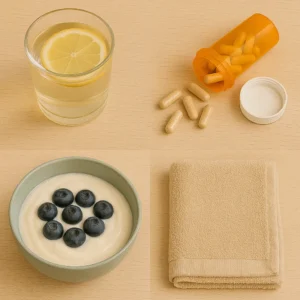White Discharge in Women: What’s Normal, What’s Not, and How to Stay Healthy
Almost every woman experiences vaginal discharge at some point. In fact, discharge is a normal and healthy part of the reproductive system—it helps keep the vagina clean, moist, and protected. But many women feel worried, embarrassed, or even afraid when they notice changes in the color, thickness, or smell of their discharge.
The truth? Not all white discharge is bad. Some types are perfectly normal, while others may signal infections or hormonal imbalances. Understanding the difference can save you stress, unnecessary guilt, and in some cases, protect your fertility.
This blog explains:
-
What white discharge really is
-
Normal vs abnormal discharge patterns
-
Causes (hormonal, lifestyle, infections)
-
When to see a doctor
-
Natural, science-backed care tips
What is Vaginal Discharge?
Vaginal discharge is fluid made up of cervical mucus, vaginal secretions, and normal bacteria. It plays three important roles:
-
Cleaning mechanism – flushes out dead cells and bacteria.
-
Lubrication – keeps the vagina moist, reducing friction and irritation.
-
Protection – maintains acidic pH (around 3.8–4.5) to prevent harmful bacteria growth.
Normal White Discharge: What’s Healthy?
According to medical experts:
-
Milky white or clear discharge is often a sign of healthy function.
-
Ovulation (mid-cycle): Discharge becomes stretchy, like egg whites.
-
Before period: Thick white discharge due to progesterone dominance.
-
During pregnancy: White discharge (leukorrhea) increases because of higher estrogen.
-
No odor, no itching, no pain → usually normal.
👉 Think of it like your body’s self-cleaning lotion.
Abnormal White Discharge: When to Worry

Changes in color, smell, or consistency may suggest infection or imbalance:
-
Thick, white, cottage-cheese like + itching → Yeast infection (Candida).
-
Thin, gray-white with fishy smell → Bacterial vaginosis.
-
Yellow-green, frothy + bad odor → Trichomoniasis (STI).
-
Pink/brownish discharge → May signal irregular bleeding, fibroids, or infection.
-
Very heavy discharge with pain → Could be pelvic inflammatory disease.
💡 If discharge is accompanied by itching, burning, pelvic pain, or foul smell, seek medical attention immediately.
Common Causes of Abnormal Discharge
-
Infections
-
Yeast infections (Candida overgrowth)
-
Bacterial vaginosis (BV)
-
STIs (Chlamydia, gonorrhea, trichomoniasis)
-
-
Hormonal Changes
-
Menstrual cycle fluctuations
-
Pregnancy and postpartum
-
Perimenopause/menopause (low estrogen → dryness + altered discharge)
-
-
Lifestyle Factors
-
Excess sugar (feeds yeast)
-
Tight, non-breathable underwear
-
Overuse of perfumed soaps or washes (disrupts pH)
-
-
Underlying Health Conditions
-
Diabetes
-
Thyroid disorders
-
Weakened immunity
-
Emotional Impact: Why Women Feel Anxious
Many women silently worry that discharge means they’re “unclean” or “unhealthy.” Some even avoid intimacy or feel ashamed discussing it with doctors.
But the truth is: most white discharge is natural and protective. Breaking the silence can help women feel safe, empowered, and in control of their health.
Natural & Medical Care Tips

✅ Healthy Lifestyle Support
-
Cotton underwear for airflow
-
Avoid douching & perfumed washes
-
Balanced diet with probiotics (yogurt, kefir)
-
Hydration & stress management
✅ When Infections Happen
-
Yeast → antifungal medicine (doctor prescribed)
-
BV & STIs → antibiotics
-
Natural soothers (like coconut oil, tea tree oil) — only under guidance
✅ Ayurvedic & Holistic Wisdom
-
Fenugreek water (hormone balance)
-
Triphala wash (mild natural cleanser)
-
Turmeric milk (immunity boost)
⚠️ These should complement, not replace, medical treatment.
When to See a Doctor Immediately
-
Sudden foul smell
-
Cottage-cheese discharge with itching
-
Discharge with pelvic pain or bleeding
-
Persistent changes despite lifestyle care
White Discharge and Women’s Life Stages
-
Adolescence (Teens): Early puberty sign, usually healthy.
-
Reproductive Years (20s–40s): Changes with cycle, ovulation, and pregnancy.
-
Perimenopause & Menopause: Less discharge, higher infection risk, vaginal dryness.
Foods & Nutrition for Vaginal Health

-
Probiotics (yogurt, kefir, sauerkraut) → restore good bacteria
-
Vitamin C & E (amla, oranges, almonds) → mucosal health
-
Zinc & selenium (pumpkin seeds, Brazil nuts) → immune support
-
Hydrating foods (cucumber, watermelon) → maintain moisture
👉 Avoid excess sugar — it feeds yeast and worsens infections.
Myths vs Facts About White Discharge
| Myth | Fact |
|---|---|
| “Any discharge means infection” | Not true—most discharge is natural. |
| “Discharge means a woman is unclean” | False—it’s the body’s cleansing process. |
| “Home remedies can cure all issues” | Some help, but many infections need treatment. |
| “Men don’t need to worry” | In STIs, partners may also need treatment. |
Preventive Care Checklist
-
Wear cotton underwear, change after workouts
-
Avoid panty liners long-term
-
Sleep without underwear sometimes
-
Wash only with lukewarm water
-
Strengthen immunity with rest, diet, exercise
Holistic Healing Approaches
In Ayurveda, white discharge (Shweta Pradar) is linked to dosha imbalance. Supportive remedies:
-
Triphala wash (balances pH)
-
Aloe vera juice (reduces inflammation)
-
Fenugreek tea (hormone support)
Modern science also supports gut health, antioxidants, and stress reduction for vaginal wellness.
Empowerment: Breaking the Silence
White discharge is not shameful—it’s communication from your body. Talking openly with doctors, partners, and daughters removes stigma and builds awareness.
Closing Wisdom
White discharge is not your enemy—it’s a message. Sometimes it says “I’m healthy.” Other times, it signals imbalance. By listening without shame and supporting your body with nutrition, stress care, and timely medical help, you transform this signal into power.
✨ Your body isn’t betraying you—it’s protecting you. Trust it, honor it, and care for it.
Conclusion
White discharge isn’t taboo—it’s a natural process. Sometimes it’s just part of a healthy cycle. Other times, it’s a sign that needs attention. By listening to your body, practicing healthy habits, and seeking care when necessary, you turn fear into empowerment.


Leave a Reply